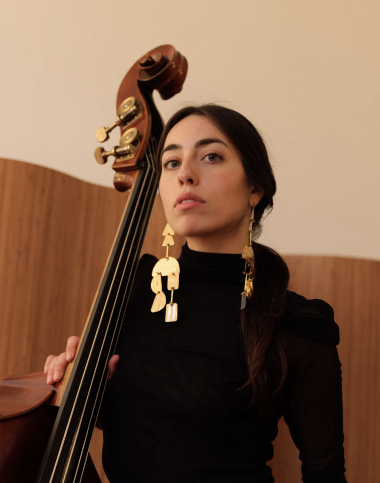
When Sugarcane ended and the last notes of Mali Obomsawin's score faded, the audience was left in silence for a few seconds – unsure whether to applaud or mourn in silence.
The 2024 National Geographic documentary directed by Julian Brave NoiseCat and Emily Kassie accompanied live by Obomsawin and her trio ensemble left a haunting echo at Stanford University’s Bing Concert Hall on Friday, Nov. 7. The acclaimed bassist, also of First Nations descent, was a perfect collaborator on the film, contributing heavily to its effect, but never for a moment calling attention to herself or her music.
The documentary tracks generations of Native families as they investigate abuses in Indian residential schools across Canada. After the Williams Lake First Nation discovered dozens of unmarked graves at former residential school sites, they began an official investigation that Sugarcane transforms into an act of mourning and reclamation. Kassie and NoiseCat, the latter of whom also appears in the film, immerse the audience into the past through videos of Native American children singing “Silent Night,” intimate conversations between NoiseCat and his father, a residential school survivor, and testimonials from Native American elders.
Obomsawin’s music, nominated for Best Original Score at the International Documentary Association Awards and Cinema Eye Honors, moves through textured soundscapes and carefully chosen silences, seamlessly accompanying the natural world of the film while amplifying its emotional gravity.
Just as the musicians transitioned seamlessly among various instruments, the score’s rhythms are tied to the film’s natural sounds — running up and down stairs, the whittling of wood, splashing water. In one scene where NoiseCat and his father drove to visit their aunt, they vocalized and sang the lyrics “Canada is all Indian land,” accompanied only by gentle drumming on the dashboard. Birdsong interjected between dialogue in the scene, but all sounds, human and animal, arose from the bodies themselves. Subtle, drawn-out notes raise tension in the film’s most emotional points and amplify silence when the audience is at a loss for words.
The audience reacted vocally and emotionally to the film’s events. When the investigators heard eyewitness testimony of an infanticide at St. Joseph’s, the people on screen weren’t the only ones crying.

In the film the story of Rick Gilbert — former Chief of the Williams Lake First Nation and residential school survivor — was particularly moving. After conducting a DNA test and discovering his biological father (Father McGrath) was a priest at St. Joseph’s residential school, Gilbert (a practicing Catholic) was invited to the Vatican where the late Pope Francis met with Indigenous Canadians to discuss reconciliation. As his wife packed his warmest socks and he diligently practiced his pronunciation of “per favore,” Obomsawin’s score with single plucked guitar strings echoes through the house.
Perhaps the most powerful moment in the film was seeing Indigenous delegates gather before the Pope. Obomsawin’s music underscored the weight of the setting, permeating the Pope’s speech and emphasizing Gilbert’s internal reckoning with the religious order that ran St. Joseph’s. It was sonorous and resonant in a way music can only be when played live, the tones vibrating beyond the screen.
The music dissipates entirely, however, when Gilbert shares his story. As he finishes, tears in his eyes, nearly ten seconds of silence fill the space before the priest, also teary-eyed, says, “I’m so sorry.” Gilbert replies softly, “we’ve heard apologies, but still nothing has happened really.”
Sugarcane does not end with resolution, but with reverberation. At Bing, that echo lingered — a reminder that remembrance itself can be a form of resistance.
To witness the film with live music was to feel history made tangible. The strings, the breaths, the pauses performed in the same room where the audience grieved, laughed, and sat still collapsed the distance between the past and the present. Obomsawin’s performance made Sugarcane less a documentary than a communal act of remembrance, where sound became ceremony. The applause, when it did come, was an acknowledgment of survival, silence, and the power of music to hold both.




